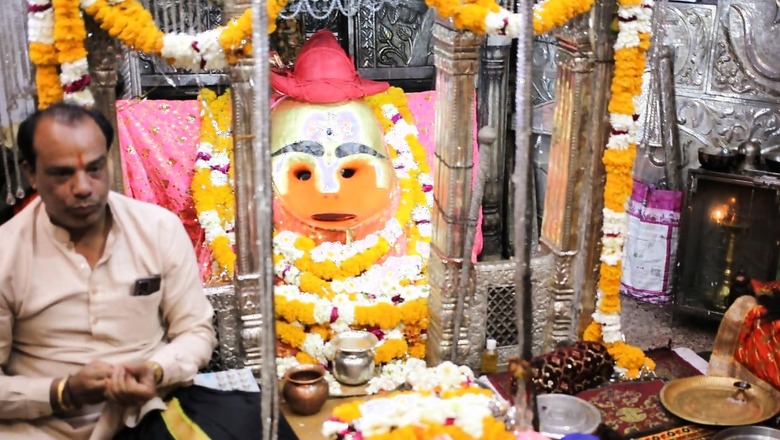
views
Madhya Pradesh Chief Minister Mohan Yadav announced a new metro city in Indore this week. Revealing a remarkable proposal, he said parts of Ujjain, Indore, Dewas and Dhar will be merged for the proposed metro city. Yadav’s strategy is rightly centered on development, economic growth, industrial growth, and regional infrastructure. The announcement is timely as he wants the state to unlock its financial and business potentials and wants to see investments pouring in.
What Yadav perhaps forgot to mention, or later must, is that the metro city could become India’s unparalleled cultural capital in 2047. MP is about to, or must, unlock a civilisational opportunity. Madhya Pradesh can use the embryonic and inherent strengths of this metro city to bring a turning point in India’s cultural upsurge which the amalgamation of Ujjain, Indore, Dewas and Dhar grandly possess and are capable of.
The quartet speaks the language of an unrelenting relationship between soil, faith, devotion, worship-propelled prosperity, preservation, history and cultural persistence. A new metro city scooped from these four cities will nudge and plough cultural paradigms that lie beneath the surface in rural life or have been unexplored, affronted and underused in urban hubs of the folk arts.
Imagine pilgrimage, art, performance, heritage and history placed on the cusp of development and cultural rejuvenation in the form of a city that’s destination, material, as well as audience of Indic culture. That could be the new metro city — if political will is in the right place.
Politics is the undeniable vector of cultural preservation. Yadav has revealed a soaring ambition of not only his government but a state that gave the NDA a clean sweep in the 2024 Lok Sabha polls. The state administration and experts are working on the blueprint for the proposed city. One might have to wait before the final plan emerges on which parts of Ujjain, Indore, Devas and Dhar would constitute it. Regardless of the ambitious composition merging the four different influences, one can confidently say that the existing cultural identity of these four geographical facets would dominate, define, preserve, and sculpt the ‘offspring’.
Reason: the four cities at the outset are strong in their own cultural and history-defined characters. They would continue retaining citizen response and footfall as coveted destinations for culture and religion in the same perspective of reach, accessibility and purpose that exists today and benefit from the improvised additions made by government interventions.
The new metro city can prove to be a turning point in India’s cultural surge towards 2047. The prime reason is strength — “Shakti”; the combined strengths of devotion, pilgrimage, pilgrims and their representation in Ujjain. Mahakaal and the Mahakaal Jyotirling, Ma Harsiddhi and Gadkalika temples, river Kshipra, and other prominent temples, have seen an upsurge and record-breaking footfalls in the recent years. Building and inauguration of the Mahakaal Mahalok Corridor was, just as expected, the turning point. The swelling footfall has ramped up local economy. All this is well-known by 2024.
Perhaps not known to many outsiders is that the bond shared by people of the four fabulous cities and their sense of culture is seeded in and shoots from Ujjain itself. The realisation of Shakti is the basis for spiritual, cultural and material prosperity — symbolised by and in the worship of Lakshmi. Knowledge is the harbinger of cultural prosperity and the pursuit of the arts. Dhar itself is the abode of Vagdevi. The path to Vagdevi’s worship in Dhar opens through Ujjain’s cultural rejuvenation, of which the new metro city will be a good representative phase.
In Ujjain and Indore, government intervention in culture — whether of the state alone, or the state-centre partnership — is largely seen as an accepted extension of that existing culture. There is a strong sense of ownership in people to preserve the ‘civilisational’. This makes it possible for the people in the region to catapult efforts, change, intangible cultural assets, to accept, aspire, to create and attract a mass audience from outside the state.
During the last three years, the Triveni Museum and cultural centre in Ujjain has presented — through visual and performing expressions — tectonic series of displays and initiatives. The museum’s inclusion in the Mahakaal Mahalok premises transformed darshan and display .
Indore in particular has immense capability to provide and create art narratives and build long-lasting audience with the region-specific interweaving of devotion, folk music, and ensembles. Owing to its geographical centrality and its spiritual proximity to Ujjain, Maheshwar, and Maharashtra, Indore has the Indic antidote to the mundane, uninspiring and meaningless entertainment that is snarling towards the National Capital Region and getting deposited on social media. As the urban leader in the proposed metro city, Indore can pull an audience through a cultural window to an ever-inspiring Madhya Pradesh and Malwi narratives in the arts. The region is a bedrock of archaeological wealth and its display.
Looking at Indore as a centre of trade alone will neglect its cultural potential in a futuristic blueprint. The importance of Holkars to Indore and Dewas, the imprint of Devi Ahilyabai Holkar on its history, should become part of Yadav government’s cultural leitmotif in establishing the new metro city. It will throw open a gateway to more meaningful public responses to cultural taking place in Indore and Devas. More importantly, it will bring Maratha architecture and the celebration of Hindustani Classical music to a fervent foreground. A creative focus on Dewas as the abode of Pandit Kumar Gandharva’s heritage with some help from and involvement of Vidushi Kalapini Komkali (his daughter) and Pandit Bhuvanesh Komkali (his grandson), is the need of the coming decade.
Ritualistic processions dedicated to Mahakaal, pilgrimage to Janapav Kuti — the janmasthali of Maharishi Parshuram situated atop a ghat on the Indore-Mumbai highway, trails across the Krishnagaman Path, Jain temples and heritage, the unique and rapturous Rangpanchamai celebrations, the Panchakosi Yatras, Ganesh Utsav and Ganesha temples, a carefully designed exploration of Kshipra and Kanh rivers leading to the pursuit of Narmada in Maheshwar and Dhar are aspects that would make the new metro city a potential nerve centre of religious tourism.
The Yadav-led government must invest some emotion and work into exploring the potentials in Monsoon-related tourism, winter-agri-tourism, rural home stays in Ujjain, Devas and Dhar and the picturesque parts of Indore. The new metro city can become a successful prototype for women-centric religious tourism, women-centric tourism, and solo woman travel. Overt dependence on the narrative of reviving and resuming the ‘night life’ of Indore would have low returns. If the government puts its mind to developing the new metro city as a tourist destination from women’s point of view, it can do wonders for the local economy. Indic women travellers can turn into effective brand ambassadors in the new metro city’s inter-state interaction.
Ujjain, one of the Saptapuris mentioned in the sacred texts, is a confluence of the worship, devotion and philosophies dedicated to Shiva, Shakti and Krishna. It’s an aspect that contributes to its definition as “Triveni”. The worship of Mahakaal, Shiva and Shakti is the nucleus of the region’s culture. While Ujjain is the point of Shiva-Shakti devotion and Simhasta convergence, Yadav and predecessor Shivraj Singh Chouhan, have made efforts to preserve the Triveni aspect of Ujjain.
For this writer, any visit to Ujjain is incomplete without a visit to the Sandipani Ashram which turns out to be an occasion to see the marked rise in the devotee footfall each time. When at the Sandipani Ashram, the devotee is also an audience to the arts. Since the building of Ram Mandir in Ayodhya, Yadav’s efforts to keep Sandipani Ashram as central to the celebration of Krishna in the region have grown.
Noteworthy is Yadav’s pointed focus on the community pitch in the celebrations of Janmashtami this year. Peeping into the new development for a mere Yadav-centric political move — as political watchers, sections of the media and his opponents have been prone to over the previous week — is tempting, reactionary and short-sighted. While one cannot deny that culture-oriented moves across India’s diverse political spectrum are political in nature, Yadav’s Krishna-oriented cultural overtures could serve a civilisational purpose for the next 100 years — right in the heart of India.
Yadav is going for a socio-cultural weaving — not only of public participation that connects prominent Krishna temples in the region, temple life and communities, but also of states, histories and philosophies.
One of the most brilliant culture-related announcements he has made since he became chief minister is that the Gita Bhawan will be set up in each city of Madhya Pradesh. This would literally bring the first source of Hindu continuity and unity — the sacred texts — to homes. His recent visit to Ayodhya is a solid example of how Yadav builds Sanatan-backed cultural assertion. Whether in Madhya Pradesh or in Ayodhya, Yadav has repeatedly mentioned the role of Samrat Vikramaditya in preserving Ayodhya.
Next: His vision on celebrating Krishna in Madhya Pradesh is centered on the Sandipani Ashram but includes the creation of the glimpse of Barsana in MP villages. Ayodhya, Mathura and Gorakhpur (the home and bastion of the Gita Bhawan) have been carefully strung to a cultural vision for Madhya Pradesh cities by him.
The importance of Ujjain as central to the Indic concept of time and the celebration of Vikram Samvat was addressed by Chouhan-led government. The subject of placing an Indic clock — named after Samrat Vikramaditya — came up. Ujjain’s Mahakaal Temple is known for its practices and role in “kaal ganana” (calculation of time). If the Yadav government picks up this thread on a serious note, it can play a role in transforming knowledge and culture-based education and public narrative.
Behind the noise of the lure of Indore’s nightlife and the hopeless pursuit for it by people and administration is an abundance of ideas that can assign the new metro city the benchmark and spot of India’s culture capital — not just of Madhya Pradesh.
The BJP in Madhya Pradesh has recognised the relevance of development as the pollinator for cultural rejuvenation. Sanatan, pilgrimage and the folk narratives are inextricably linked to the cultural work that Indore, Ujjain, and Dewas inspire as cities. A thread of internal cultures ties the four cities together. Its essence was understood and preserved by the Holkars and the Rajas of Dewas.
Cities as the bastions of art and music have kept tradition alive and absorbed into the mass milieu. However, making a new metro city hold the existing dominance of four centres of tradition, history and heritage alongside a massive people-oriented, agri-inclined, industry-hinged, employment-aimed development movement in a nodal confluence has been a thing of imagination so far. Not when you are in MP.
It’s tempting to politicians and the press to mention the National Capital Region when referring to the new metro city in MP. That must stop before it begins in the context of culture. Here is why: Centered upon the dominance of New Delhi, even the National Capital Region has failed to create a verve for the masses as a common platform for culture. The defined parts of culture are literally locked inside the fancy auditoria of South and Central Delhi and Gurgaon. The undefined is assigned to fairs and seasonal melas. The devotional lies affronted and unvisited. Then, what’s coming to or being platformed in Delhi’s culture scene, is barely Delhi’s own. It’s no hidden secret that the most meaningful engagement with art and culture in NCR, as of today, is what travels from the ASEAN countries, or the forest dwellers of India, or the gharanas of the classical arts, or as indigenous narratives.
What Indore would bring, as a new cultural capital, would be very much its own. It would be a confluence, blend, essence of traditional, the ‘performed’ and most importantly, the ritualistic before it bleeds into the ‘contemporary’. The new metro city, if shaped as a global destination for Indic culture, can actually play a role in raising the standard of contemporary forays arriving from Indian metros. Moreover, the new metro city will have capacity to turn the creation of art, and the absorption of culture — by turning them — from the organiser to the audience. That parts of NCR are ruled by three different governments and two parties currently could be one reason. Lack of political will and the absence of collaboration between governments — another reason. The new metro city will have none of these political challenges.
There is a marked difference in the urban aesthetic distinguishing Indore and Ujjain. The proposed city would do well with a confluence of the best of visual languages that define the architectural, cultural, historic, literary and heritage facets of Ujjain and Indore. Regardless of what parts of Ujjain fall into the new proposed metro, the state government with some interest and involvement of the Scindias, must first focus on the neglect of and preservation of the Kaliadeh Palace. The state government needs to crack a whip on activities that interfere with the architectural complex and the water tanks, lake and the banks of Kshipra. Next: restoring permanently the name of River Kahn (mispronounced in local parlance) and giving it due importance in the geography and region’s cultural rejuvenation.
Sculptural enhancement of the roundabouts in Ujjain is rare, out of the box, traditional yet contemporary. It adheres to an unseen script that relates to the city’s history and past. The creative philosophy behind them can drive the visual impact in the new metro city.
In 2022, the Centre set up seven zonal cultural centres for the development of the arts, culture and craft. These were Patiala, Nagpur, Udaipur, Prayagraj, Kolkata, Dimapur, and Thanjavur. The assimilation of Ujjain, Devas, Indore and Dhar makes the yet-to-be-named proposed metropolitan city a deserving candidate for demanding its own zonal cultural centre. The BJP-led government’s experimentation with the concept of crafts and agri-product haats and grams within Ujjain is modest. Keeping Shilpgram at the forefront in the integrated elements at the Zonal Cultural Centre at the new metropolitan city, backed by programmes centered on the promotion of the folk visual and performing art narratives, research and documentation will weave local, agri-influenced economies into cultural rejuvenation.
Reports point that Yadav mentioned the government’s focus on increasing the export of chickpea while referring to the creation of the new city. Chouhan at the helm of the Centre-state partnership would help.
Interestingly, Yadav made this announcement at the Kabuli Chana Traders’ Association meeting held in Indore. Kabuli Chana is chickpea — just one element in the agri-diversity rich Madhya Pradesh. Yadav has recently toured Mumbai, Bengaluru and Coimbatore to promote MP as a business destination and encourage investments, business and trade in the state. Metro rail, the current lease of development in Indore, and the rightly placed obsession with cleanliness in the region, are advantages.
His focus is also on making the state a bigger contributor to the food industry. Bringing the youth to the food processing industry for employment could become a major thrust in his plans for the metro city. Yadav mentioned chickpea from Indore being exported to 60 countries as a “matter of pride.”
Establishing the new metro city as a power centre of trade, industry and economy means that Yadav will be going all out in using the existing strengths of agri-diversity, land, infrastructure and commerce. The “pride” factor will feature big in the scheme of changes and development and Yadav has verbally built the atmosphere of “collective participation”, connected it to national prosperity. For now, he has stated that his government would try to resolve issues related to stock limits and problems faced by traders.
There is a possibility of greater Centre-state partnership and an indication of a potential shift in the cultivation culture. At the traders’ conference in Indore, Yadav reportedly mentioned the higher yield of chickpea against irrigation requirements of wheat. As seen in Ujjain and other centres of tourism in Madhya Pradesh during 2022 and 2023, the state government participated whole-heartedly in the celebration of millet in Narendra Modi’s Sree Anna thrust on creating nutrition security and the welfare of millet-growers. The Yadav-Chouhan team can erect bold teamwork connecting farmers and traders with a nutrition and food security-centered cultural movement — straight out of the new metro city they have known like the back of their hands. Any massive shift in cultural resurgence emerging in the proposed metro city could prove to be a turning point for India.

















Comments
0 comment